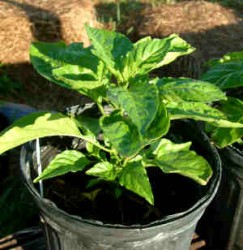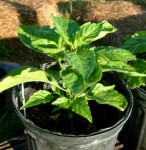Bhut Jolokia – The World’s Hottest Pepper
Bhut Jolokia is the reigning world’s hottest pepper. The most pungent tested over 1,000,000 Scoville Units. That’s beyond hot!
I decided to grow some jolokia in my garden, along with some mustard habanero and some scotch bonnet peppers. The ultimate comparison should be quite interesting!
About Bhut Jolokia
 This nuclear-heat chile pepper is known by several names. In addition to Bhut Jolokia, it’s also known as Naga Jolokia, Nai Miris, Ghost Chili, Ghost Pepper and Naga Morich. Yes, it’s a little confusing (to say the least).
This nuclear-heat chile pepper is known by several names. In addition to Bhut Jolokia, it’s also known as Naga Jolokia, Nai Miris, Ghost Chili, Ghost Pepper and Naga Morich. Yes, it’s a little confusing (to say the least).
This chile pepper comes from the Indian sub-continent, and thought to have originated in Northeast India, in Nagaland.
There’s been some controversy over this pepper; some say that the testing (done by 3 different labs) was hoaxed and nothing could top 1 million Scoville. But, the Chile Pepper Institute, run by New Mexico State University, ran tests in 2005 and yes, it was over 1,000,000 Scoville.
In February 2007, Guinness World Records certified the Bhut Jolokia (Prof. Bosland’s of the Chile Pepper Institute’s preferred name for the pepper) as the world’s hottest chili pepper.
There’s a question if the jolokia pepper is a member of the capsicum chinense or capsicum frutenscens family. I’m going to go with c. chinense, because the plant looks very similar to the Mustard Habanero plant I am growing in a different part of the garden.Â
(You can read read my pepper types post for more information on the different species.)
Growing Bhut Jolokia
The seeds aren’t exactly cheap (I paid about $1 per seed), and I started 2 seeds. Both sprouted, but one was felled by (I assume) the weather. The other one is doing beautifully!
The photo above is about a week before I planted it in my new raised bed garden. Since it’s been in the raised bed it has flourished and is a beautiful plant. It’s just now starting to form some flower buds, and before the buds open, I am going to bag the blossoms, so I can be sure of having more seeds going forward.
I’ll be posting more about Bhut Jolokia, the world’s hottest pepper, in the future, especially once the peppers start to form. And it will be quite interesting to compare it against my Mustard Habanero and Scotch Bonnet Early peppers.
Stay tuned!
About Chile Peppers
Chile, chili, hot — what’s the difference? None, really. These pungent peppers are often called by any of the above names.Â
Chile peppers are members of the genus Capsicum, and they are unrelated to black peppercorns (part of the Piper family). For convenience, however, we’ll only use the term “chile” when referring to these peppers. Please note, however, that there are several varieties that are actually have the word “chile” in their name.
Chile Pepper Facts
Where Did Peppers Come From? The hot chile pepper is a New World addition to the diet, discovered by none other than Christopher Columbus on his first voyage in 1492. Today, we know of more than 200 varieties, over 100 of which are indigenous to Mexico.
Are Peppers Good for You? Fresh chile peppers are loaded with Vitamin C — twice as much as citrus fruits! Fresh chiles also contain Vitamin A. What about dried? Well, drying chiles destroys most of the Vitamin C, but increases the Vitamin A content — up to 100 times! Some weight-loss programs advocate the use of spicy foods (chiles included), saying that the heat generated by the spice revs up the metabolism.
How Hot is “Hot”? Back in 1902, a scientist by the name of Wilbur Scoville devised a test to measure the relative heat of the chile peppers. This resulting scale is referred to as the “Scoville Scale”. For example, bell peppers register a “0-100” on the Scoville, while the mighty habanero registers a whopping “300,000+”. That’s hot!
Here’s a list of commonly eaten peppers, with their Scoville rating (from mildest to hottest):
- Bell peppers with a rating of 0-100
- Anahaeim peppers with a rating of 500-3,500
- Ancho/Poblano peppers with a rating of 500-1,000
- Pasilla peppers with a rating of 1,000-3,000
- Numex/New Mexico peppers with a rating of 3,000-4,000
- Hungarian peppers with a rating of 3,500-4,500
- Jalapeno peppers with a rating of 5,000-7,000
- Serrano peppers with a rating of 6,000-10,000
- De Arbol peppers with a rating of 15,000-30,000
- Cayenne peppers with a rating of 30,000-50,000
- Chipotle/Morita peppers with a rating of 75,000
- Chiltepin/Birdseye peppers with a rating of 50,000-100,000
- Scotch Bonnet peppers with a rating of 200,000
- Habanero peppers with a rating of 300,000+
- Habanero “Red Savina” with a rating of around 500,000
- Jolokia is now the official hottest, with a rating of over 1,000,000!
Now these numbers aren’t chisled in stone; for example, there are jalapenos that have practically no heat, as well as some that are extra hot. Different varieties of the same pepper can have different Scoville ratings. Add to that is this little fact; the hotter the climate where the pepper is grown, the higher the Scoville rating.
What Makes Chiles so Hot? A substance called capsaicin is what makes the chiles to hot! The more capsaicin, the hotter it is. Pure capsaicin tops out the Scoville scale with a rating of 16,000,000!
Too Hot! How Can I Cool my Mouth? First of all, do not drink beer, water or a carbonated beverage — it will just make things worse! Capsaicin is an oil, and these liquids just spread it around. Try drinking milk, or eating some sour cream (or ice cream). Dairy items neutralize the oil and cool the burn.
Can I Lower the Heat of a Pepper? Sure! If you want to reduce the flames (so to speak), you can “neuter” the pepper by paring away the interior ribs and removing the seeds. If the pepper is a really hot one, you might not notice a great difference, though.
How Can I Determine the Heat of an Unfamiliar Pepper? Assuming that you don’t want to taste-test the pepper, here’s a general rule-of-thumb — the bigger the pepper, the lower the heat. The reverse is generally true as well — the smaller the pepper, the hotter it is.
Where Can I Get Chiles? Chiles are increasingly available in grocery stores, but why not grow your own? They’re fun to grow, and you can be sure they’re fresh. Also, growing your own chile peppers allows you to grow the varieties that you like — not what the grocery store buyer thinks you should like.
How Long Will a Pepper Plant Live? This all depends on the species of pepper plant. There are three main cultivated species: Capsicum annuum, Capsicum frutescens, and Capsicum chinense. Most peppers grown are of the Capsicum annuum species, and so are annual plants (living only one year). The Tabasco pepper (Capsicum frutescens) also lives a similar time. On the other hand, Capsicum chinense, otherwise known as the Habanero or Scotch Bonnet, is a perennial in a semi-tropical or tropical environment. In addition, the Capsicum baccatum, of which Ajis are a member, can also occasionally live more than one season.
